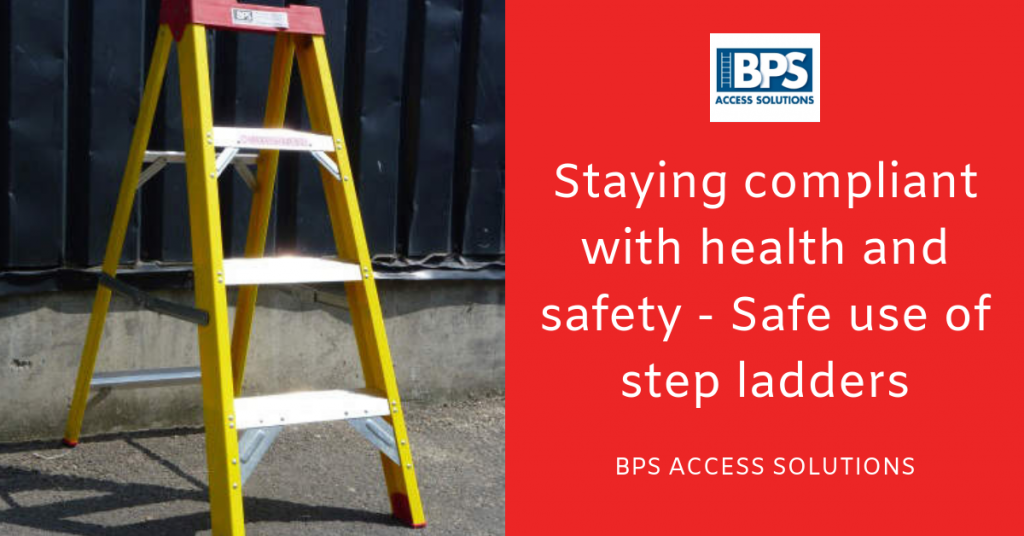Staying compliant with health and safety: Safe use of step ladders
When using step ladders it is essential that you comply at all times with the health and safety requirements. Step ladders are very practical and useful equipment to use, however, this does not mean that they should not or cannot be misused or mistreated as this could result in serious injury or fatality. Step ladders are a common sight both on commercial and residential locations demonstrating their appeal and popularity across multiple purposes and customers and therefore also increasing the potential for accident and injury to the users. As such this blog will aim to make clear the need to conduct yourself safely and securely on step ladders to endure the safety of yourself and others.
- Firstly it is necessary before even stepping foot on the ladder to examine it and check that it is in good working order before you use it. To do this you must check each part of the ladder making sure that they are all safe and correctly functioning. Start with the locking bars. These must be securely attached to the ladder to support the weight of the ladder and any additional load once the ladder is extended and in use. If the bars are loose or damaged then you must not attempt to use the ladder until this is repaired, which to ensure maximum safety should be carried out by a professional who can make the ladder safe again. Until this is done you must not use the ladder and make clear to others that they must not either until repairs are complete or a replacement is available.
- Next, you should check the feet of the ladder, if the feet are missing, then refrain from using the ladder as without feet it could be at risk of sliding and falling which is a major concern. Similarly, if the feet are damaged or worn then you must seek a repair or replacements before using the ladder because to climb without secure feet would be dangerous. The feet of the ladder provides the friction and stability to the ground allowing the user to climb the ladder with a solid fixture on the ground. Once the feet are replaced or are in a suitable condition it is safe to climb, provided the other checks are completed and are also safe.
- Then it’s the steps/treads, these need to be inspected to be able to provide the necessary support to the user as these will bear much of the weight and if they are broken or damaged then they could well give way causing a serious accident to occur. Once again if the steps/treads are damaged or faulty then the ladder must be taken out of use until this fault can be fixed at the earliest opportunity. Equally, If there is contamination on the steps that could pose a risk as they could be slippery do not use until the steps/treads are clear of any potential hazard. Once these are cleared you can move on to the next check.
- The stiles are the next part to check as these hold the ladder together and with weak or damaged stiles that ladder is in an unsafe condition as it could collapse when climbed if the stiles were to break. These stiles may not look that important, but they are imperative to the frame of the ladder and so must be kept in good condition in order to perform their function and keep the ladder together. Ensuring that the stiles are secure and are not bent or deformed in any way is one aspect of checking the stability of the ladder. Making sure that you check the overall stability and strength of the ladder before use and that every part of the ladder is in a safe and working condition before committing yourself to the ladder is a vital part of ladder safely as much but not all of the ladder safety is performed with your feet on the ground.
- Secondly, once you have established that the step ladder is safe to use you must then be cautious and take care to climb the ladder in a slow and steady way in order to keep your balance and not risk a weight distribution problem. Stepping with one foot at a time while holding on to the ladder is required to provide enough stability and the grip to hold on if you slip or wobble. Maintain three points of contact on the ladder with hands and feet, stay in the middle of the ladder once you are on it. Be aware that you must use the ladder within the limits specified by the manufacturers, step ladders can have a reduced height, but don’t assume they are not dangerous to climb and you can’t have an accident and injure yourself because you can very easily indeed.
- Don’t use the top two steps of the ladder, they are to provide stability with the other side of the ladder and therefore are not designed to be stepped upon even if they look similar to the other steps. Don’t overload that ladder, the ladder has a specified weight limit that you should be aware of before you use the ladder. Do not put too much strain on the ladder as this could cause an accident. Further to that point, don’t allow more than one person on the ladder at once, they are designed and made for one person. Don’t open the ladder while standing on it. It is essential that you open the two parts of the ladder whilst on the ground to make sure the ladder is safe before use. Attempting to assemble the ladder whilst on it could cause serious injury. Do not attempt this.
This blog has highlighted some of the serious risks involved in using step ladders unsafely. Taking this advice should ensure that you use a step ladder safely and avoid injury. If you would like more information, please contact BPS who will be happy to help with any inquiry you have.
No related posts.



